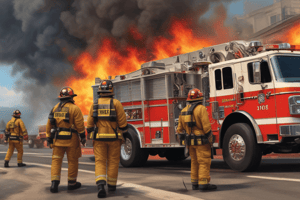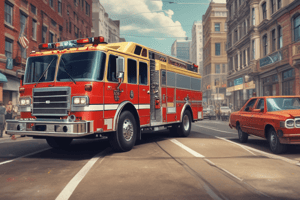Podcast
Questions and Answers
When a firefighter transmits a 'MAYDAY', what specific action is expected from all units on the frequency?
When a firefighter transmits a 'MAYDAY', what specific action is expected from all units on the frequency?
- Cease all transmissions to ensure clear communication for the 'MAYDAY' call. (correct)
- Immediately transmit a reply to acknowledge the 'MAYDAY' call.
- Immediately shift to an alternate frequency to avoid interference.
- Continue regular transmissions but prioritize the 'MAYDAY' call.
What is the primary responsibility of the Incident Commander (IC) when a firefighter transmits a 'MAYDAY'?
What is the primary responsibility of the Incident Commander (IC) when a firefighter transmits a 'MAYDAY'?
- Contact the Northwest Central Dispatch (NWCD) and report the 'MAYDAY' call.
- Facilitate communication by repeating the 'MAYDAY' message and giving the firefighter priority. (correct)
- Provide immediate assistance to the firefighter in distress.
- Evacuate all other personnel from the immediate area of the incident.
Which of these actions is NOT required of a firefighter who transmits a 'MAYDAY' call?
Which of these actions is NOT required of a firefighter who transmits a 'MAYDAY' call?
- Activating the emergency button on the radio.
- Using any available means to draw attention to their location.
- Activating the PASS device once the 'MAYDAY' is acknowledged.
- Confirming their location with the Incident Commander (IC). (correct)
In what scenario is the 'EMERGENCY TRAFFIC' call used instead of a 'MAYDAY' call?
In what scenario is the 'EMERGENCY TRAFFIC' call used instead of a 'MAYDAY' call?
What is the difference in communication priority between a 'MAYDAY' and an 'EMERGENCY TRAFFIC' call?
What is the difference in communication priority between a 'MAYDAY' and an 'EMERGENCY TRAFFIC' call?
Which of the following statements accurately describes the role of the Northwest Central Dispatch (NWCD) in responding to a 'MAYDAY' call?
Which of the following statements accurately describes the role of the Northwest Central Dispatch (NWCD) in responding to a 'MAYDAY' call?
Why is it important for a firefighter to activate their PASS device after acknowledging a 'MAYDAY' call?
Why is it important for a firefighter to activate their PASS device after acknowledging a 'MAYDAY' call?
What action can terminate an 'EMERGENCY TRAFFIC' call?
What action can terminate an 'EMERGENCY TRAFFIC' call?
What is a situation that would warrant the use of a 'MAYDAY' call?
What is a situation that would warrant the use of a 'MAYDAY' call?
When should 'EMERGENCY TRAFFIC' be initiated?
When should 'EMERGENCY TRAFFIC' be initiated?
Which of the following is NOT a valid reason to call a 'MAYDAY'?
Which of the following is NOT a valid reason to call a 'MAYDAY'?
What does the term 'MAYDAY' primarily signify in firefighting operations?
What does the term 'MAYDAY' primarily signify in firefighting operations?
How should communication be structured when 'EMERGENCY TRAFFIC' is called?
How should communication be structured when 'EMERGENCY TRAFFIC' is called?
Which situation describes the proper context for shifting from offensive to defensive operations?
Which situation describes the proper context for shifting from offensive to defensive operations?
Which of the following is a correct response to a firefighter who is out of SCBA air?
Which of the following is a correct response to a firefighter who is out of SCBA air?
What does the five air horn blasts signify in the context of emergency protocols?
What does the five air horn blasts signify in the context of emergency protocols?
Flashcards are hidden until you start studying
Study Notes
MAYDAY and Emergency Traffic/Evacuation
Purpose
- The "MAYDAY" alert notifies all personnel on an emergency scene that rescue efforts are needed for a firefighter in danger.
- "Emergency Traffic" ensures quick, uninterrupted communication to the Incident Commander or Dispatch in perilous situations.
Definitions
- "MAYDAY" is used when a firefighter(s) is in danger, such as:
- Injured and needs immediate assistance
- Lost or missing
- Trapped
- Out of SCBA air
- Any circumstance that can seriously injure firefighter(s)
- "EMERGENCY TRAFFIC" is used to alert others of a perilous or dangerous situation, such as:
- Structural collapse without entrapped firefighters
- Burst hose line
- Rapidly changing fire or incident conditions
- Evacuation of the structure or area followed by five air horn blasts
- Change from Offensive to Defensive Operations
Procedure for MAYDAY
- Any unit or firefighter encountering a dangerous situation uses the "MAYDAY" term to alert others.
- The term "MAYDAY" is repeated two or three times over the radio and receives the highest communications priority.
- All units on the radio frequency cease transmissions, and the frequency belongs to the individual giving the "MAYDAY" call.
- The Incident Commander considers moving other radio traffic to an alternate frequency.
Procedure for EMERGENCY TRAFFIC
- Any unit encountering a perilous situation uses the "EMERGENCY TRAFFIC" term to alert others.
- The term "EMERGENCY TRAFFIC" receives a high communications priority.
- Units initiate emergency communications by verbally contacting the Incident Commander or Northwest Central Dispatch.
- All units on the frequency cease transmissions, and the frequency belongs to the unit giving the "EMERGENCY TRAFFIC" call.
Studying That Suits You
Use AI to generate personalized quizzes and flashcards to suit your learning preferences.




